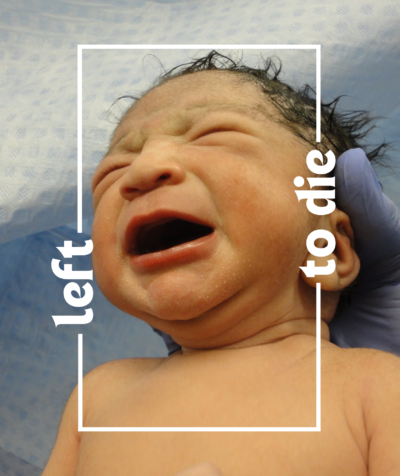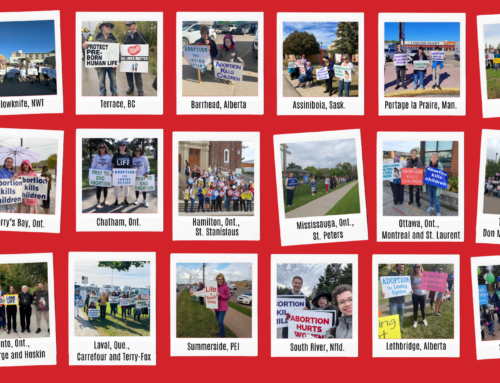By Joanna Alphonso:
 The purpose of abortion is to terminate the life of the unborn child. When that fails, and the child is born alive, he or she is simply left to die. This is happening right here, at home, in Canada.
The purpose of abortion is to terminate the life of the unborn child. When that fails, and the child is born alive, he or she is simply left to die. This is happening right here, at home, in Canada.
Canada is the only country in the Western hemisphere without a law on abortion. As a result, abortions are legally being committed at all stages of pregnancy, including just before birth. The Interim reported earlier this year on the shocking lack of statistics on the diverse backgrounds of women who seek abortions. The only reported parameters are provincial setting, age range, method of abortion, and how the data was collected from abortionists as well as what the code for the specific procedure was.
Campaign Life Coalition reported in 2023 that 1,500 babies were born alive after abortion over the span of 23 years. This was an increase in the number of failed abortions with a gestational age of over 29 weeks, noting that babies are viable outside of the womb at 24 weeks with medical intervention. CLC commented that the only trace of their existence in data were health codes, such as “P96.4 – Termination of pregnancy, affecting fetus and newborns.” This code does not include stillbirths resulting from abortions.
Details of their deaths remain unknown. Pete Baklinski, CLC director of communications, speculated that the abortionists responsible for ending their lives within the womb may have ended their lives in the same way as convicted U.S. abortionist Kermit Gosnell, who would use scissors to sever the spinal cords of babies born of failed abortions.
This data was based on collections from the government’s Canadian Institute for Health Information (CIHI), tracked and analysed by dedicated Canadian pro-life researcher Patricia Maloney. She has been researching born-alive abortions and other abortion-related Canadian statistics since 2012.
Maloney found that in 2021-2022 alone, there were 149 live-births resulting from abortions – an increase from 127 in the previous year. Maloney pointed out CIHI’s admission that their data is incomplete and under-reported due to lack of statistics from Quebec in their written summaries of statistical reports.
Tristin Hopper, reporter for the National Post, reported in 2013 that Conservative MPs Maurice Vellacott, Leon Benoit, and Wladyslaw Lizon wrote to the Royal Canadian Mounted Police (RCMP) commissioner urging investigation into the apparent homicides of at least 690 children that were born alive during late-term abortions. The MPs wrote that between 2000-2009, 491 aborted babies exhibited evidence of life post-abortion, including a momentary heartbeat, sudden gasp, and in rare cases, crying. Hopper also reported that “in a vast majority of Canadian abortions, the child does not receive any documentation, since it is deemed to be bodily discharge.”
Canadian law recognizes humanity of the child from the moment the child has “proceeded, in a living state, from the body of its mother,” in section 223(1) of the Criminal Code. The Code in section 238(1) also states that anyone killing an unborn child in the act of birth, such that the child is legally a human being, would be guilty of murder.
In their letter to the RCMP, the MPs suggested that live births following abortion called for application of section 223(1) of the Code if the procedure resulted in the death of the child by intent, or lack of care.
Hopper interviewed Dr. Eike-Henner Kluge, former director of ethics and legal affairs for the Canadian Medical Association, for insight on how hospitals deal with live-births following abortions, due to its grey area in law. “Doctors have a duty to do the best they can for what is now a person in the eyes of the law,” Kluge said.
Rather than imparting critical and life-saving care for vulnerable human beings with legal protection, Kluge speculated that in the 491 cases, this duty would have likely extended only to keeping the babies comfortable and pain-free until they died. Hospitals tend to have a policy to ensure termination of the child’s life in-utero, usually by lethal injection, to avoid legal complications and psychological trauma for staff.
In 1985, Ximena Renaerts was left to die in Vancouver General Hospital after her mother crossed the border to ensure her death, Terry O’Neill reported in a 1999 edition of BC Report newsmagazine.
Twenty-two-year-old Nadine Bourne had an abortion in Bellingham, Washington, and was suffering complications. Four days later, she went to the Vancouver hospital to seek treatment. She told resident Dr. Jaroudi that she was 14 to 16 weeks pregnant, but Dr. Jaroudi did not find evidence of the child’s existence. A short time after, Nadine gave birth to her daughter, Ximena, while seated on a commode. Ximena weighed about three pounds, which indicated that Nadine was much further along than what she claimed.
Court records showed that nurse Vera Wood did not call a “code blue,” or the “infant transport team” following the birth. Ximena was clearly struggling, but viable. Wood instead placed Ximena in the room where they stored dead fetuses. Ximena was left there for about 40 minutes according to court documents.
One such document showed evidence of severe trauma including brain damage, mental retardation, and cerebral palsy as a result of acts and omissions by the hospital’s employees. After those 40 minutes, Wood called another nurse, Joyce Hatherall, who finally provided Ximena with warmth and cleared her air passages. Dr. Jaroudi instructed the nurses not to resuscitate the baby, and to “let it go.” Hetherall ignored him. She did not talk about her role in savimg Ximena’s life; rather, it traumatized her.
Ximena lives with her adoptive family in Chilliwack, B.C. She still suffers due to her inhumane treatment following her birth. She is a quadriplegic with the mental capacity of a three-year-old. Her adoptive mother remains heartbroken at her daughter’s suffering. “How can you ever bring justice when all the damage is done,” she commented in O’Neill’s report, “I guess my big hope that what happened to Ximena won’t be in vain. It could be you in the hospital and what if they feel that you’re not worthy of life? We have to stop somewhere.”
A preliminary investigation in Ximena’s treatment was started by the police, but no prosecution ever occurred. Police spokesman Sergeant Bob Cooper called the case a “bull****” one, similar to cases where babies die during delivery by midwives. After a subsequent investigation, it was abandoned by the police within a few weeks. This was in spite of several applicable charges under the Code, including abandonment likely resulting in permanent injury, criminal negligence and reckless disregard for the lives of others, and homicide of a child after passing from the body of its mother in a living state.
B.C. lawyers Charles Lugosi and Thomas Berger settled Ximena’s case at $8.7 million in 1999. Lugosi wrote a press release where he mentions other abortion survivors, including Gianna Jensen, Melissa Ohden, Claire Culwell, Josian Presley, and Nik Hoot. He also mentions that abortion survivors tend to be neglected by choice of hospital staff, resulting in catastrophic injuries, and all staff involved ought to be found liable criminally and privately by lawsuit.
Hopper also reported on investigations in 1999 of a Calgary hospital where another baby was born alive after an abortion, but had no Joyce Hatherall. This child had a genetic anomaly, resulting in missing vital organs.
A 1999 report by Richard Cairney in Features Chroniques discusses private documents on genetic terminations occurring in Calgary’s Foothills General Hospital leaked to Alberta Report by pro-life nurses. Although the Calgary Regional Health Authority (CRHA) successfully got a court judgment preserving the confidentiality of the documents, the documents had already impacted the public.
The Alberta Report article compared Foothills’ practice of genetic terminations to the 1930s eugenics movement. It also concluded that the practice “unquestionably constitutes murder,” and “the abortionist might well be guilty of culpable homicide.” It also reported that the documents reflected the violation of conscience rights on nurses who were given no choice but to participate in these practices, with no regard for their religious and moral objections.
Dr. John Jarrell, CRHA chief medical officer at that time, said that genetic terminations took place when tests showed that the fetus, if born, would “not be compatible with life.” These conditions included renal agenesis, thanatophoric dysplasia, and anencephaly. Jarrell told Cairney, that providing abortions “is truly one of the few remaining areas in medicine where, I think, some fairly substantial courage is required for people to provide this type of care. It is important that this courage gets acknowledged, that people are willing to look after individuals who are in very upsetting circumstances. They are to be commended.”
But who looked out for Ximena in her very upsetting circumstance? Who looked out for all of the other babies born alive after abortions and their very upsetting circumstances?
Although nothing more can be done for their short lives, earlier this year CLC wrote a letter to RCMP Commissioner Mike Duheme to investigate what now totals over 1500 intentional or negligent deaths of babies born alive following failed abortions. This letter was accompanied by the signatures of more than 4700 Canadians in support of this investigation. At the time of the MPs letter to then-Commissioner Rob Paulson in 2013, he responded that there was a “lack of relevant information or substantive facts about a specific crime” to warrant an investigation.
What happens to babies born alive behind the closed doors of abortion mills remains unknown due to lack of evidence. The stories of Ximena, Foothills, and 1,500 babies in Canada and more than 85,817 stories since Roe v Wade throughout the US as reported by Abortion Survivors Network, allow the public to speculate that these babies have no chance of survival, short of heroes like Joyce Hatherall.




